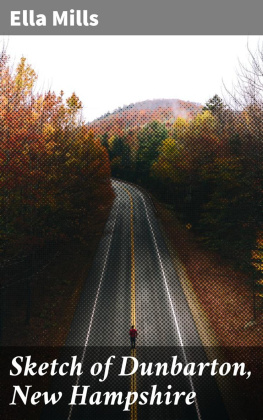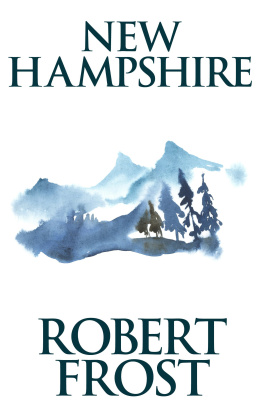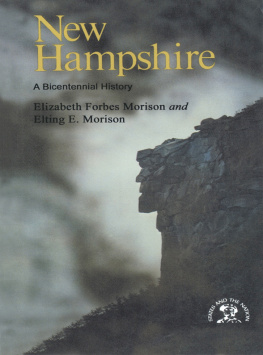Dunbarton is a town "set upon a hill which cannot be hid." The highest point of land is on the farm of Benjamin Lord, north of the Center, and is 779 feet above the sea level. From that spot, and from many other places nearly as high, the views of hills and mountains are beautiful and grand beyond description.
The twin Uncanoonucs are near neighbors on the south, Monadnock, farther off on the south-west, and Kearsarge twenty miles to the north west. On the northern horizon are seen Mount Washington and other peaks of the White Mountains.
The longest hill in town is the mile-long Mills hill, and midway on its slope live descendants of Thomas Mills, one of the first settlers. Among other hills are Duncanowett, Hammond, Tenney, Grapevine, Harris, Legache, and Prospect Hills.
No rivers run through the town, but there are numerous brooks where trout fishing is pursued with more or less success.
No body of water is large enough to be called a lake, but Gorham Pond is a beautiful sheet of water and on its banks picnics are held. Stark's and Kimball's Ponds have furnished water power for mills, the latter, owned by Willie F. Paige, is still in use. Long Pond, in the south part of the town, was the scene of a tragedy in 1879, when Moses Merrill, an officer at the State Industrial School, Manchester, was drowned in an ineffectual attempt to save an inmate of that institution.
One portion of the south part of the town is called Skeeterboro, another Mountalona, so named by James Rogers, one of the first settlers, from the place in Ireland from whence he came. East of the Center is Guinea, so called because some negroes once lived there. The village of North Dunbarton is also called Page's Corner; and not far away to the eastward is a hill known as Onestack, because one large stack of hay stood there for many years. A brook bears the same name.
Those who know Dunbarton only in the present can hardly realize that 1450 people ever lived there at one time, but that was the census in 1820. The first census, taken 1767, was 271. In 1840 it was 1067; in 1890, only 523. The last census gave about 575.
The first settlement was made in 1740 by James Rogers and Joseph Putney on the land known as the "Great Meadows," now owned by James M. Bailey. They were driven away by the Indians for a time. A stone now marks the spot where stood the only apple tree spared by the Indians. Probably the first boy born in town belonged to one of these families. James Rogers was shot by Ebenezer Ayer, who mistook him in the dark for a bear, as he wore a bearskin coat. He was the father of Major Robert Rogers, celebrated as the leader of the ranger corps of the French and Indian wars.
About 1751 William Stinson, John Hogg, and Thomas Mills settled in the west part of the town. Sarah, daughter of Thomas Mills, was the first girl born in town. Her birthplace was a log cabin on the farm now owned by John C. and George F. Mills.
For fourteen years the town was called Starkstown in honor of Archibald Stark, one of the first land owners (though not a resident), and father of General John Stark. In 1765 the town was incorporated, and was named, with a slight change, for Dumbarton in Scotland near which place Stark and other emigrants had lived.
Dunbarton was one of the towns taken from Hillsborough County to form the County of Merrimack. Its centennial was duly celebrated and attended by a vast concourse of invited guests and towns people. A report of its proceedings was compiled by Rev. Sylvanus Hayward. Though small in area and population, Dunbarton occupies a large place in the hearts of its sons and daughters. However dear our adopted homes may become, we still feel that "whatever skies above us rise the hills, the hills are home."
At the centennial Rev. George A. Putnam paid a glowing tribute to his native town, saying: "Dunbarton is one of the most intelligent and best educated communities in New England. I think it will be hard to find another place where, in proportion to its population, so many young men have been liberally educated and have entered some of the learned professions, where so many young men and women have become first class teachers of common schools. My own observation has been altogether in favor of Dunbarton in this particular. And it is clear as any historic fact the superior education of Dunbarton's children has been largely due to her religious institutions and Christian teachers."
That the town is also honored by her neighbors is shown by the following instances: Many years ago it was said that a Dartmouth student from an adjoining town, when asked from what town he came, answered: "From the town next to Dunbarton." Recently the chairman of the school board in Goffstown, in his annual report, compared the town favorably to Dunbarton with regard to the number of college graduates.
Very soon after the permanent settlement of the town, a committee was appointed to build a meeting-house at Dunbarton Center. It was finished previous to 1767, and stood in the middle of the common. Before that time it is related that "Mr. McGregor preached in the open air, on the spot now consecrated as the resting place of the dead." This first building was a low, frame structure, without pews, with seats of rough planks resting on chestnut logs, and a pulpit constructed of rough boards. It was replaced in about twenty years by the building now known as the Town House. This was used only for political purposes after the erection of the third church on the west side of the highway.
About thirty years ago the interior of the old building was greatly changed, the upper part being made into a hall while the square pews were removed from the lower part, only the high pulpit remaining. A selectmen's room was finished in one corner, and in 1892, a room for the public library. The outside remains practically unchanged.
The Rocky Hill Church at Amesbury, Mass., much like this at Dunbarton, is still used in summer only. There is no way of warming it, and people of the present day would not endure the hardships their ancestors bore without a murmur. The third church was built in 1836 on the site of a dwelling house owned by William Stark; in 1884 it was remodelled, the pews modernized and the ceiling frescoed.
The vestry formerly stood on the opposite of the common and contained two rooms; prayer meetings were held in the lower room, while up stairs was the only hall in town. There were held the singing schools, and the lyceum of long ago; also several fall terms of high schools; among the teachers were Mark Bailey, William E. Bunten, and Henry M. Putney. More than twenty-five years ago the vestry was removed to its present location near the church and made more convenient and attractive.
For about nineteen years the church had no settled pastor. In 1789 Walter Harris was called, and was ordained August 26. He preached more than forty years. Every man in town was required to contribute to his support for a time until some of the other religious societies rebelled. The "History of Dunbarton" says: "Dr. Harris appropriated the proprietors' grant for the first settled minister, and located himself on the ministerial lot. He also, by a vote of the town, obtained the use of the parsonage lot, with an addition of seventy pounds a year, one-half to be paid in cash, the other in corn and rye." His farm was in a beautiful location south of the center, and was afterwards owned for many years by the late Deacon John Paige; it is now the property of his son, Lewis Paige.













